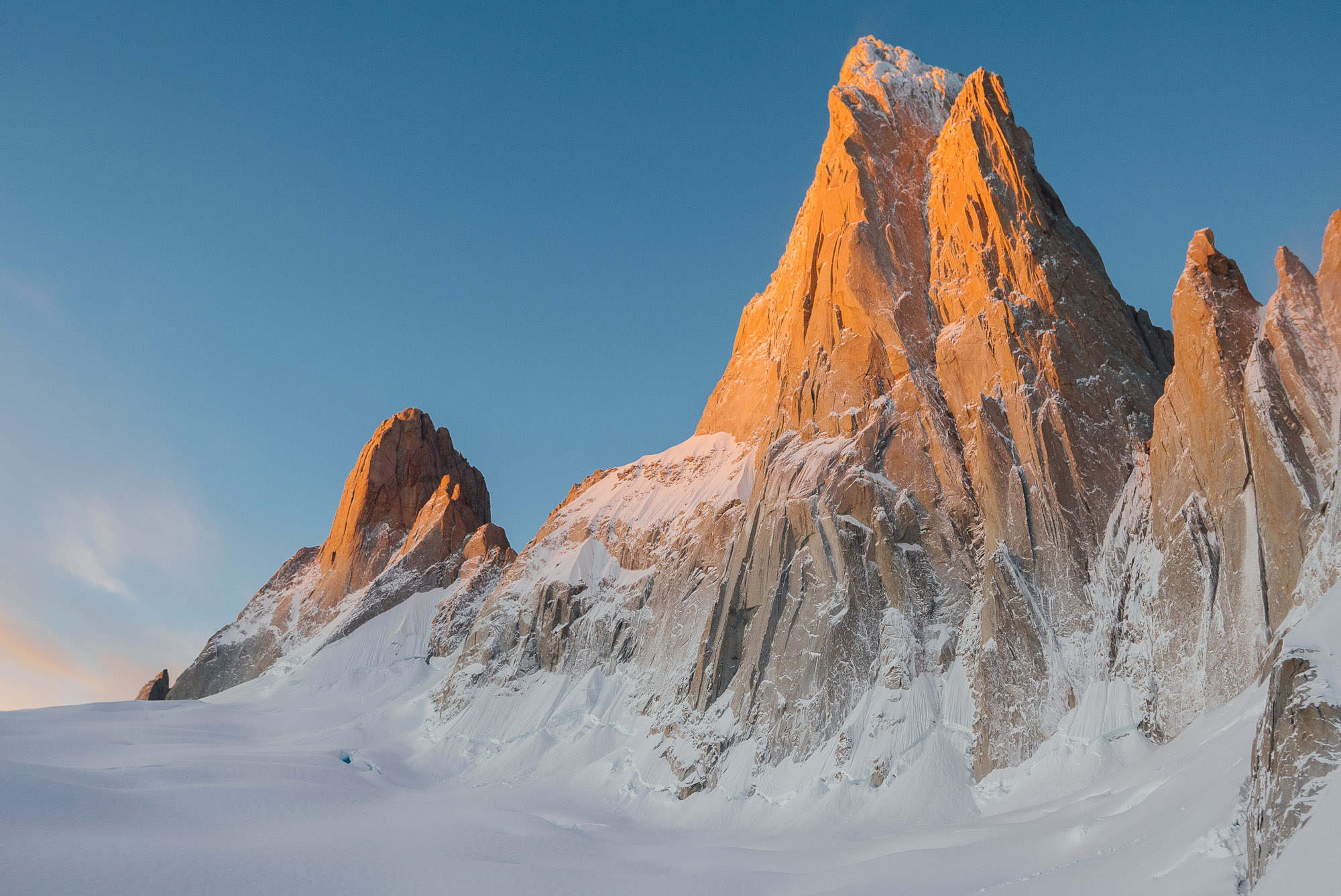
Fitz Roy and Poincenot, early morning.
Patagonia
I wasn’t sure what to expect going into my trip to Patagonia. I had just emerged from a period of low motivation and I wasn’t sure I was quite through with it yet. Would I feel like I was wasting my time and taking unnecessary risk? Was I going there just because it was the thing to do? Patagonia was a place I had dreamed of going to, but maybe I’d feel out of place…like I shouldn’t be there.
I think I went at a good time though. With the skills and experience I’d acquired over the last couple years, Patagonia ended up feeling like something I could truly enjoy. I wasn’t overwhelmed by it. I was ready for it. I made safe decisions and I had fun. And it honestly was some of the most inspiring climbing I’d ever done.
Five weeks were set aside for the trip. Pretty much the month of February. A good amount of time. Three weeks seems like the absolute minimum to give yourself a fair shot of climbing something, as the weather could be bad for weeks on end. With five weeks, I should for sure be able to climb something… Even then I wondered if I’d have enough time.
I came into the trip with zero expectations. I knew that if the weather was bad in the mountains, you could still boulder in Chaltén, the town climbers stay in. That was the only expectation I did have. I joked that it would be my longest bouldering trip. I’d never been on one longer than a few days, but maybe the weather would be so bad that I’d just boulder for five weeks. I was prepared to be OK with that. That mindset proved to be a good one because the first two weeks I was there, I only bouldered. And it’s not a bad backup plan—the bouldering is really good. We met several climbers who traveled to Chaltén just for the bouldering. The pad situation, however, is not good, and I ended up mostly climbing on boulders that the locals had padded or climbing traversing problems low to the ground that needed little to no padding. The traverses got a little old by the end of the trip. It’s nice to climb up.
The daily routine in Chaltén starts out with coffee brought from the States—because you can’t find good coffee down there—and reading weather forecasts. “When’s the next window?” was the question constantly in our minds. Often what seemed like a clearing a week out would completely disappear in a few days, and most “windows” would deteriorate in length and quality by the time they finally arrived. A couple times it looked like we were going to get a four or five day “mega window,” and both ended up being merely one, or maybe two separate days of good weather.
There is a lot of pre-window talk down there. Everyone wants to know what everyone else is planning on climbing. But the talk was usually a waste of time because the weather changed so much. Before most windows, we didn’t have a solid-ish plan till the day before. One time we didn’t decide which side of the range we’d hike into until 30 minutes before leaving.
Finally a three day window arrived—really just two good days with a bad day in the middle. The first day of that window was going to be too cold to rock climb, so Austin Siadak—my main climbing partner for the trip—and I decided that we should go for a “winter” route—basically a route we could climb in boots, crampons, gloves, and ice axes, verses “rock climbing” with bare hands and rock shoes. We decided to try the Whillans-Cochrane on Poincenot.
Poincenot, the third highest peak of the Torre and Fitz Roy spires, is one of the most beautiful in the Fitz Roy group. Its prominent and piercing spire competes with Fitz Roy (Cerro Chaltén, as it’s locally known) itself. Due to recent warm weather and storms, the snow ramp leading to the start of the “technical” climbing was melted out and then covered with fresh storm snow. We arrived at the base of the route as several parties were bailing. The loose snow over rock didn’t look ideal. I was psyched to have Austin’s Patagonia experience for what turned out to be an earlier-than-expected crux at the beginning of the route. If it weren’t for him, I would have joined the fleeing parties.
Once we made it to the mixed “crux” (M4 or 5 in the current conditions), I took the lead, only because I felt bad about all the leading Austin had been doing up to that point. After navigated a scary slab in crampons, we were cruising on solid rock and good ice—comfortable territory for both of us. As we rounded the mountain and made it to the summit, I got my first views of the Torres—some of the most beautiful spires of rock in the world. Even though I never got to touch rock with my bare hands and rock shoes, Poincenot was an amazing and very memorable first Patagonian climb for me. It was also important for Austin—it was the last spire in the Fitz Roy skyline that he had not climbed.
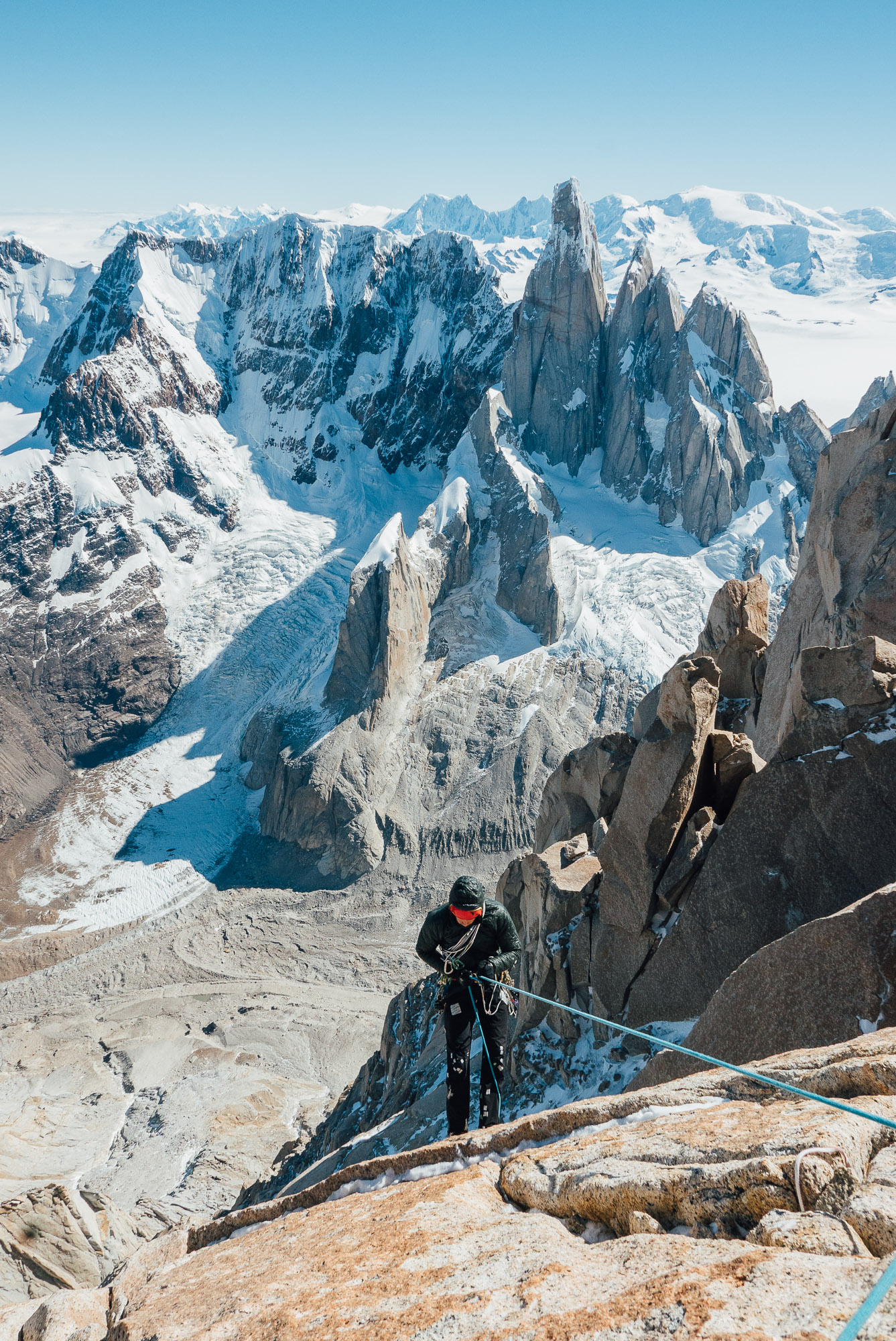
Austin rapping off the summit of Poincenot with the Torres in the background.
After Poincenot, Austin and I rested out a rainy and windy day in high camp and prepared to attempt Aguja Pollone with Colin Haley and Andy Wyatt the next day. We planned to climb a route called La Granja via the Japanese direct start as two teams of two. The pitches on this route ended up being some of the best alpine rock pitches we’ve ever climbed. Splitter hand and finger cracks, and hero jug flakes. The whole route follows a prominent eastern arête that juts out over an epic glacial landscape. The quality of the climbing, the beauty of the line, the mountain, and position make this route destined to be a classic. The whole day was type-1 fun—a rarity in such serious mountains.
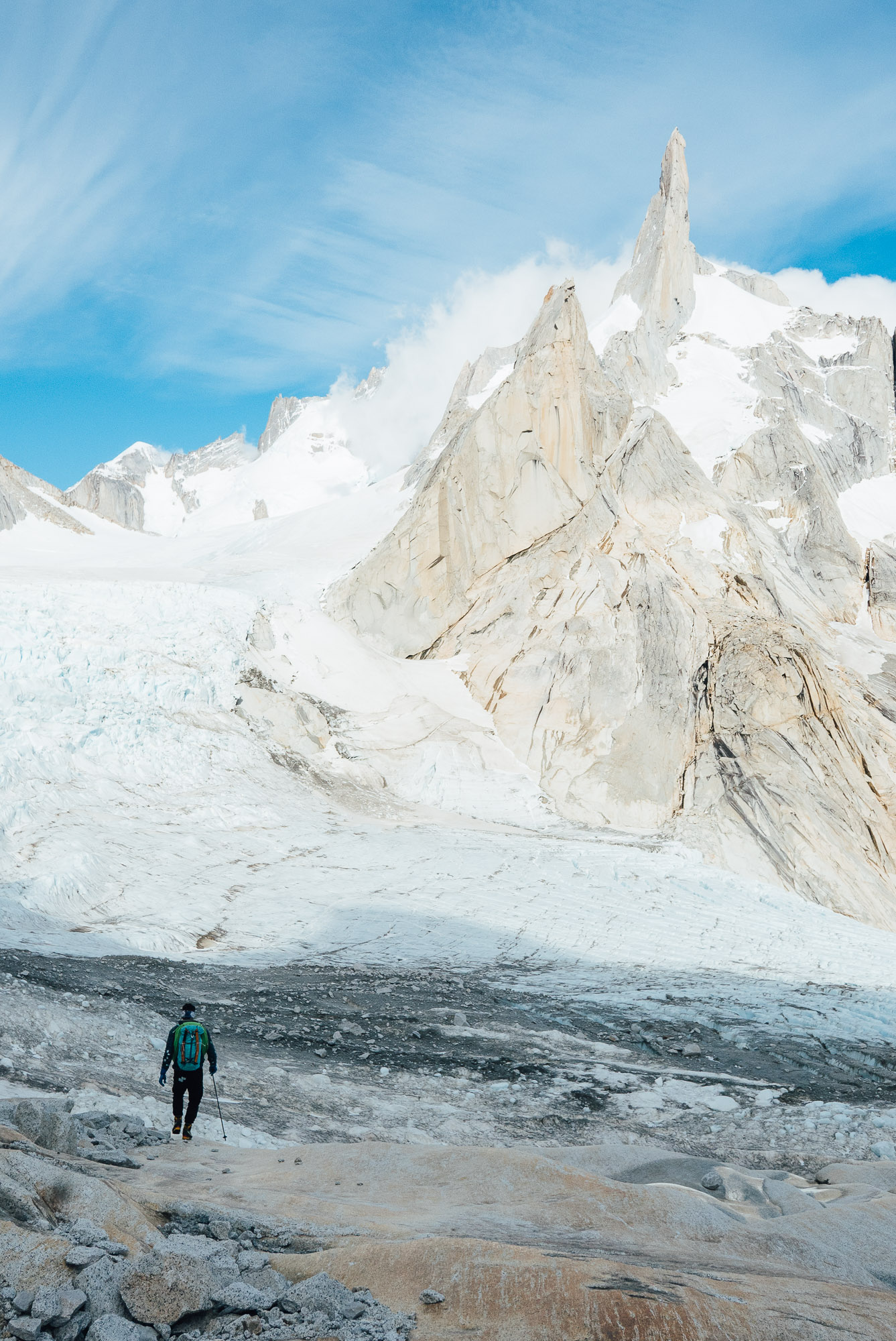
Colin approaching Aguja Pollone.
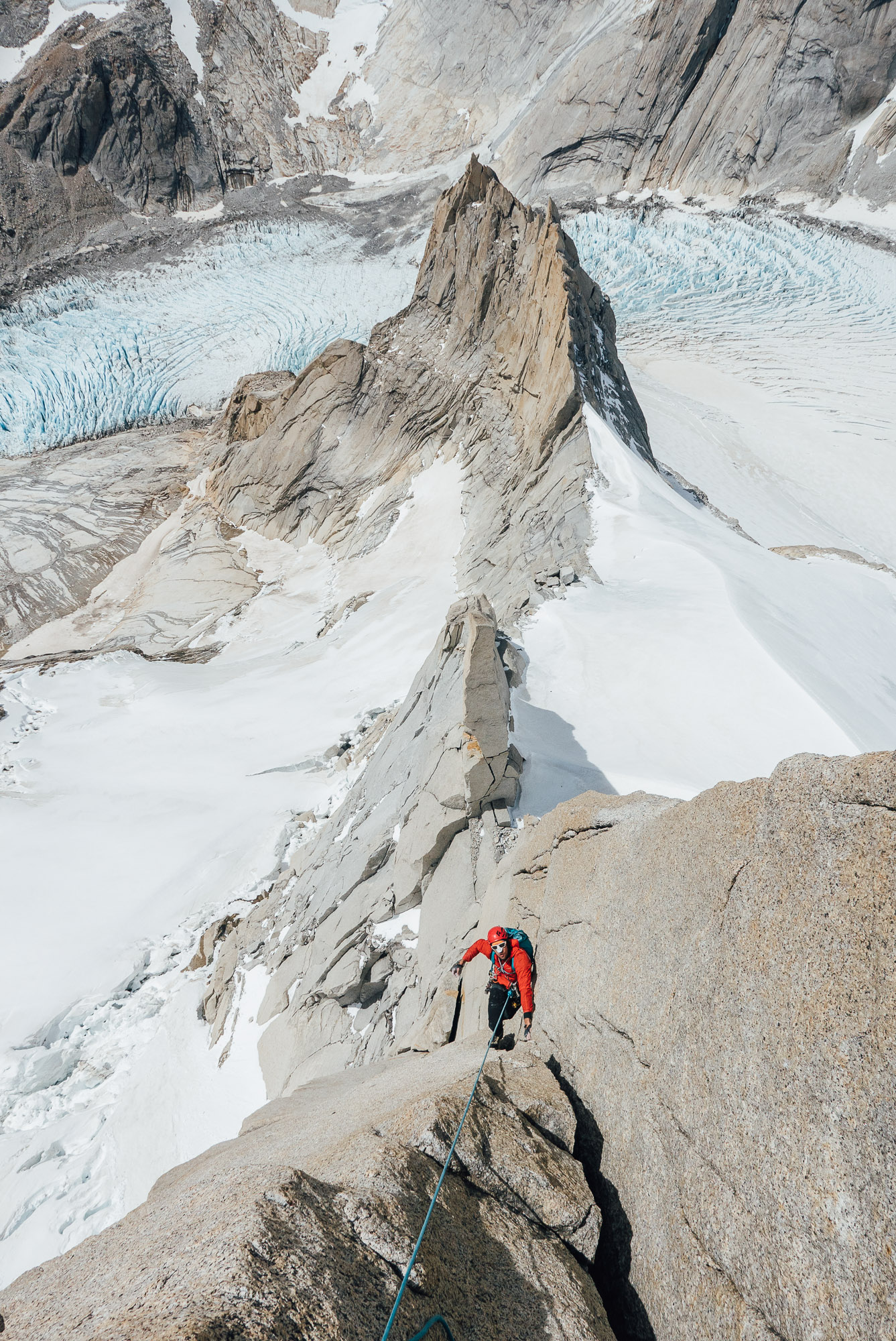
Austin on one of the many amazing pitches of La Granja.
Back in town, we did more bouldering and trail running and religiously checked the forecasts for the next window. The scene in town is beautifully social—lots of climbers hanging around and waiting for good weather. El Chaltén is small, but because of its booming recreational appeal as the “trekking capital of South America,” it has many small grocers, cafes, restaurants, and even a brewery. Most days in Chaltén ended with happy hour at “Fresco,” where climbers gather and share stories of the last window, celebrate successes, and bond over surviving another day in Patagonia.
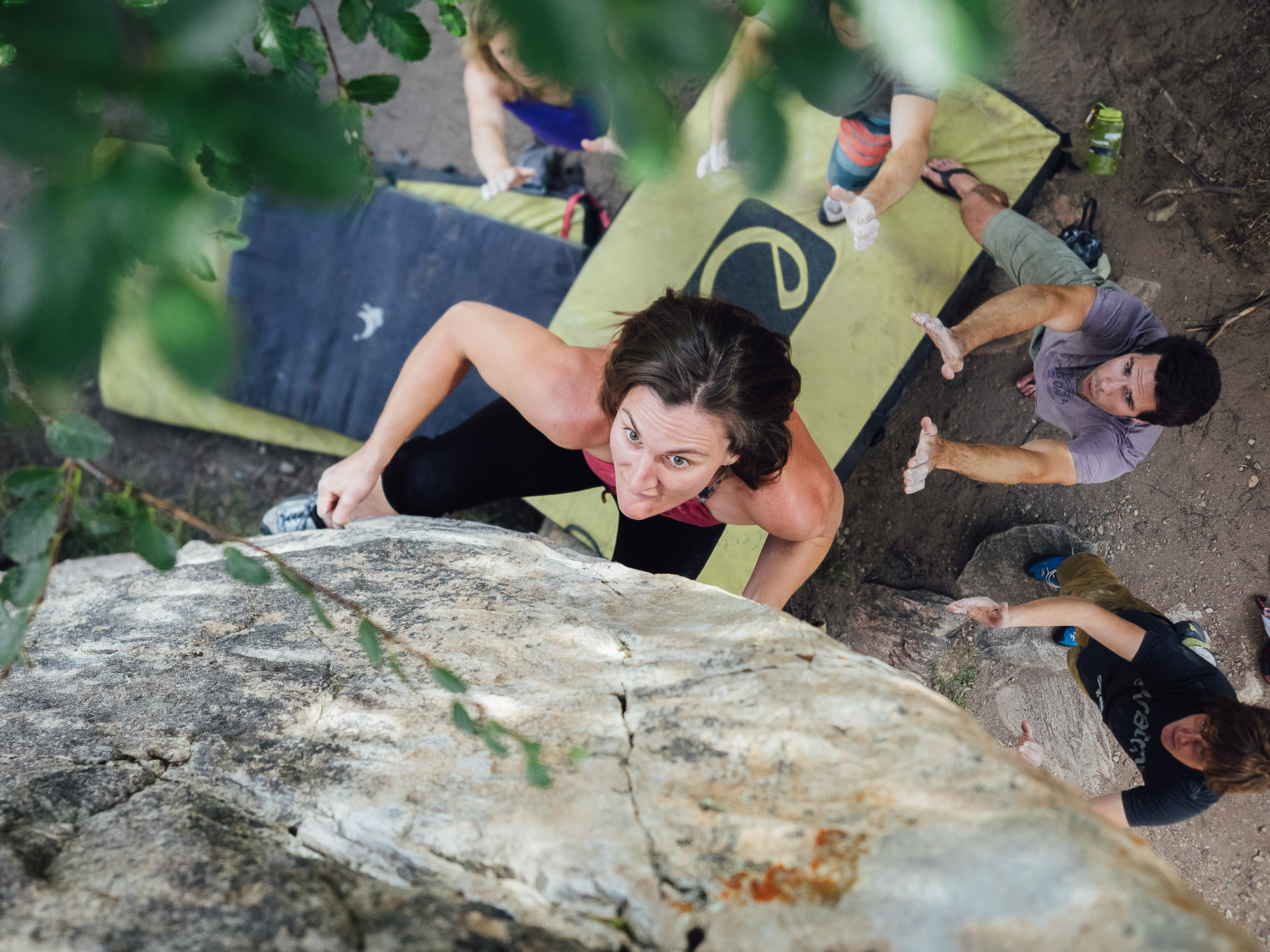
Josie trying to decide if she wants to go for it.
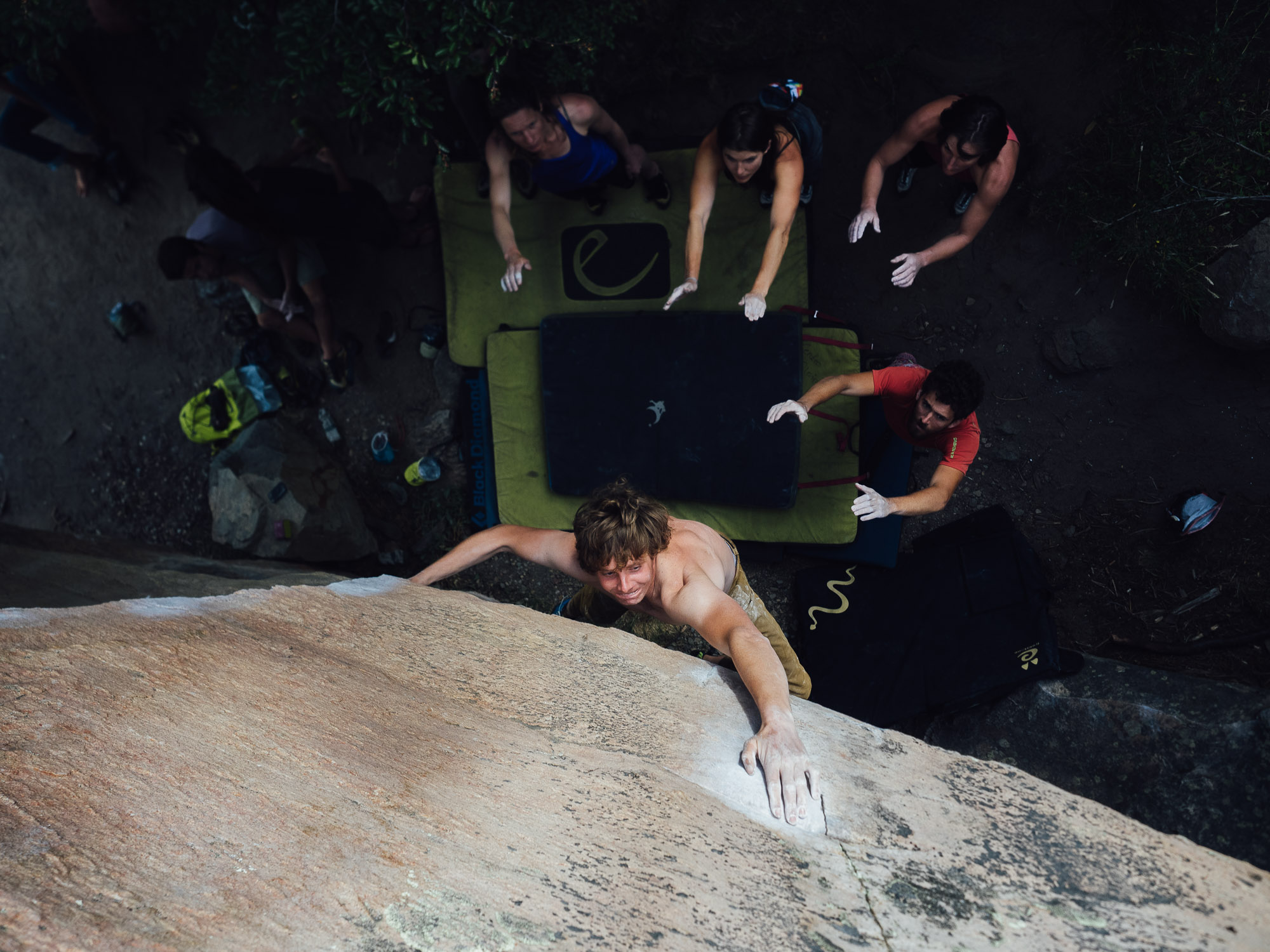
Will on 'Gato Negro.'
Later that week we got a small blip of good weather—not enough time to spend a night in high camp—so we would have to get in and out of the mountains Chaltén-toChaltén. Andy and I decided to team up to do a quick climb of Guillaumet, a mountain neither of us had climbed and one of the most accessible for a town-totown mission. Andy is the owner of the climbing gym I routeset for and super talented athlete. Him and Colin Haley set the car-to-car speed record of Fitz Roy and, back in Washington, Mt. Stuart's North Ridge. I was excited to see if I could keep up!
We climbed a “sit-start” to the most popular route, the “Fonrouge”—in total, a 2500-foot ridge climb. The day, although windy at times, was beautiful, and the route was easy enough to climb mostly unroped, save a few pitches. The route could be considered the “North Ridge of Stuart” of Patagonia…although not quite as good. We traveled about 18 miles that day, climbed a 2500-foot route, gained 6500 feet, all over about 11 hours—still a lot of ground to cover for being one of the most accessible routes! (A couple weeks later, a group of climbers did that same thing two hours faster!)
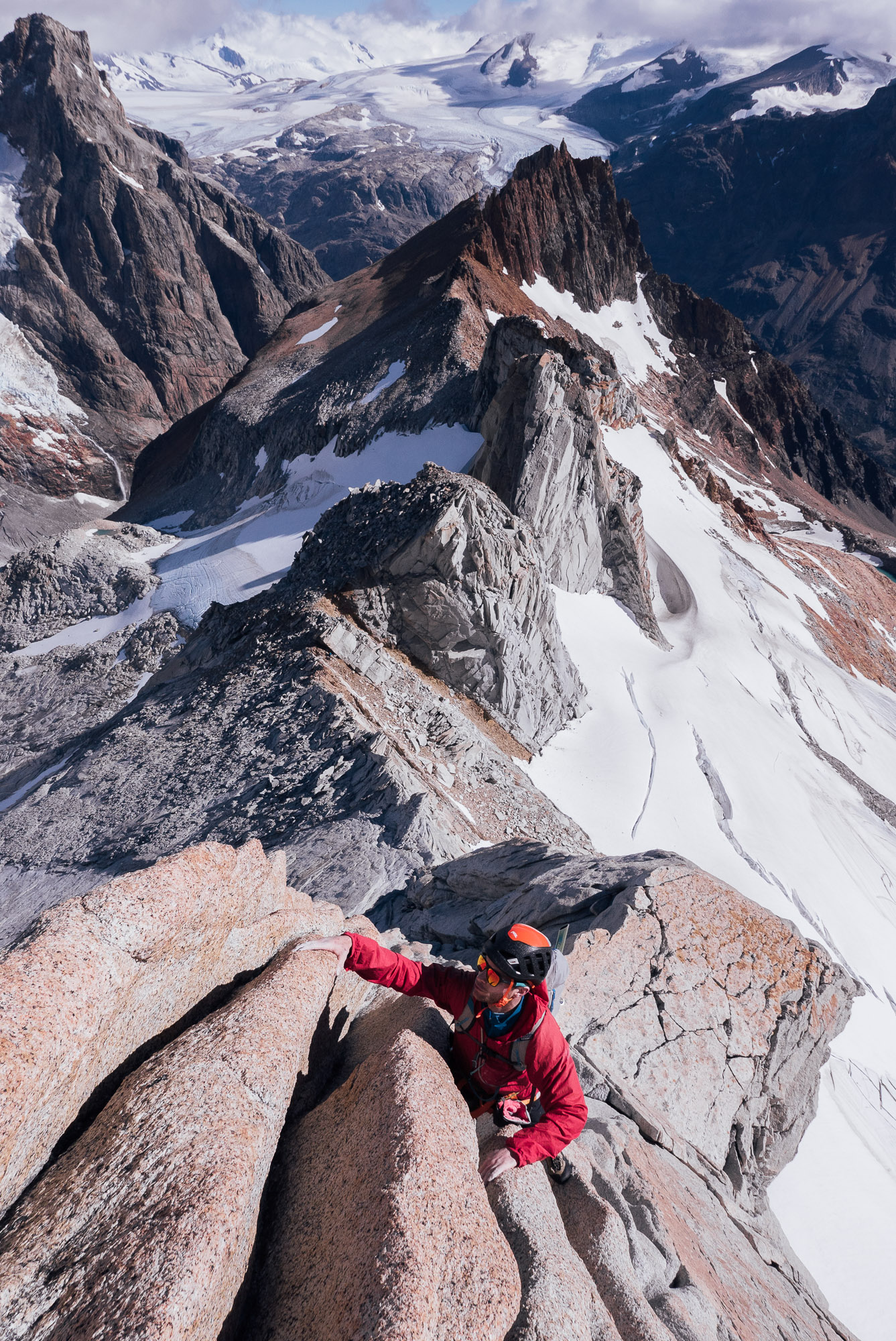
Andy low on the ridge.
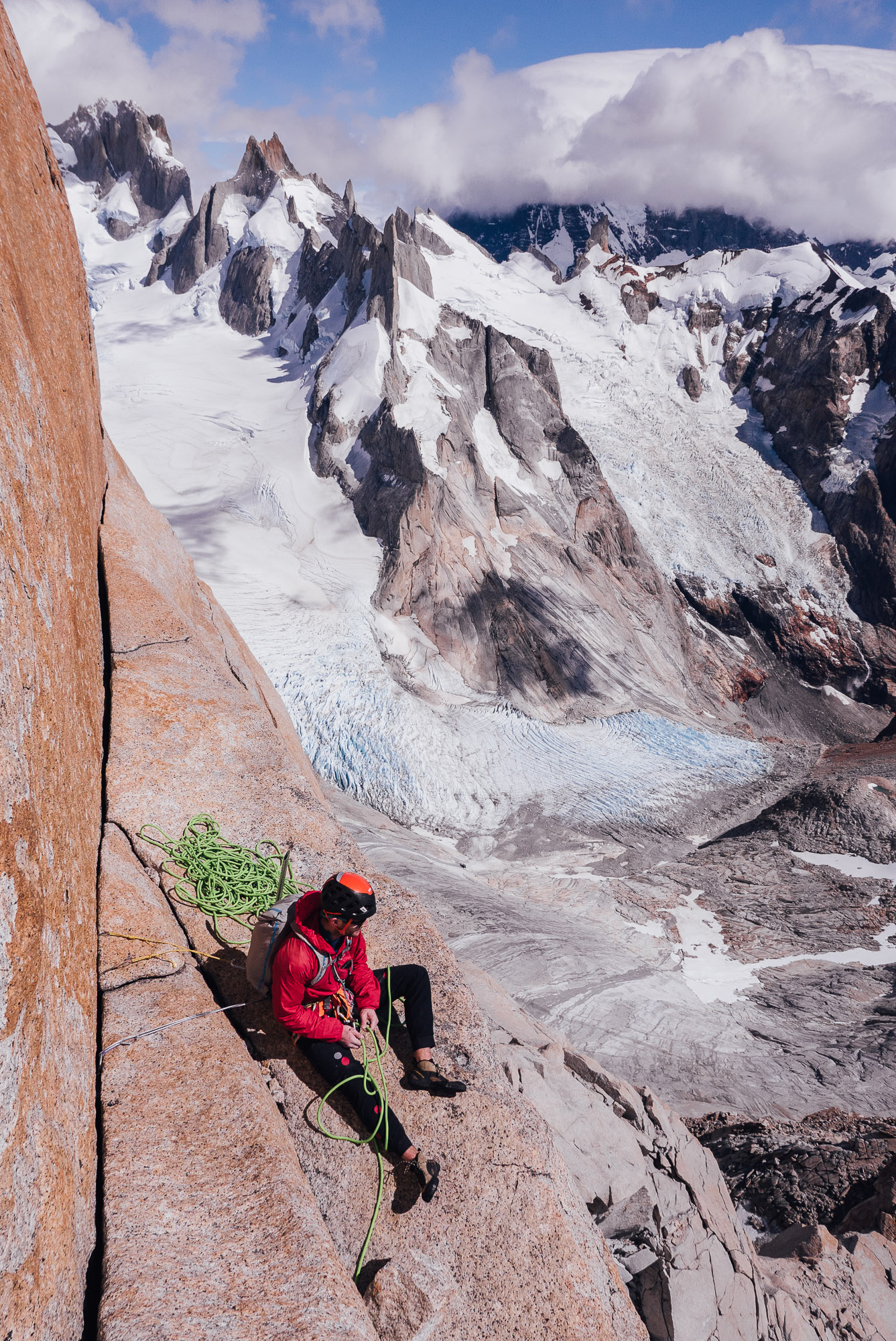
Andy at a belay after the crux pitch of the Fonrouge.
Three weeks had flown by and I was beginning to feel like I was running out of time. Eventually some promising weather showed up on the horizon. But first more bouldering, trail-running, and happy hour-ing.
I would of loved to do something new in the mountains down there—a first ascent or a first free ascent. For me climbing is more rewarding the more it is creatively expressive. But ultimately we never got the weather, and for the little windows we had my priority was to just explore and get to know the range and climb some of the classics. I did, however, come out of the trip with a Patagonian bouldering first ascent—one of my most memorable experiences down there. At the annual Festival de Boulder in Chaltén, I climbed on several freshly cleaned boulders that some locals prepared just for the festival, and I managed to be the first to climb one of them, quite possibly the “king line.”
The line goes straight up a tall and clean 40° overhang with cool holds and great movement—about all you could ask for. When I walked up to people trying the line, most of the climbers were taking epic falls from the top, missing the pads, and thankfully being caught by a large group of spotters. I assumed someone had already climbed it and I gave it a few tries, dropping off each time because I was scared. Then I heard that it actually hadn’t been climbed yet, so I decided to give it a little more effort. After a couple more tries, I found a body position in which I felt in control, committed to the last few moves, and pulled over the lip. I felt like I was competing again, and it brought back a exhilarating memory of a cheering crowd when I was the only person to send a route at nationals. I called the line La Puerta Abierta, “The Open Door,” upon recommendation from Austin who heard someone yell, “the door is open!” after I topped it out. The name also recognizes those who worked hard to prepare and save this boulder for the festival. It’s about V9, with maybe a half-grade granted to it due to its committing nature.
Finally, in my last week, some good weather came and Andy, Austin and I decided to try a route out of the Torre Valley. We attempted “Last Gringos Standing” on St. Exupery, but only got a couple pitches up before bailing because of wind and cold. I think that day turned out to be much colder than expected and a number of parties had to bail. Perhaps we could have chosen an easier and more sheltered route, but I’m not sure we could have known how bad it would be. Our one failure still ended up being a great camping trip—the Torre Valley is likely the most beautiful place I’ve ever been in my life.
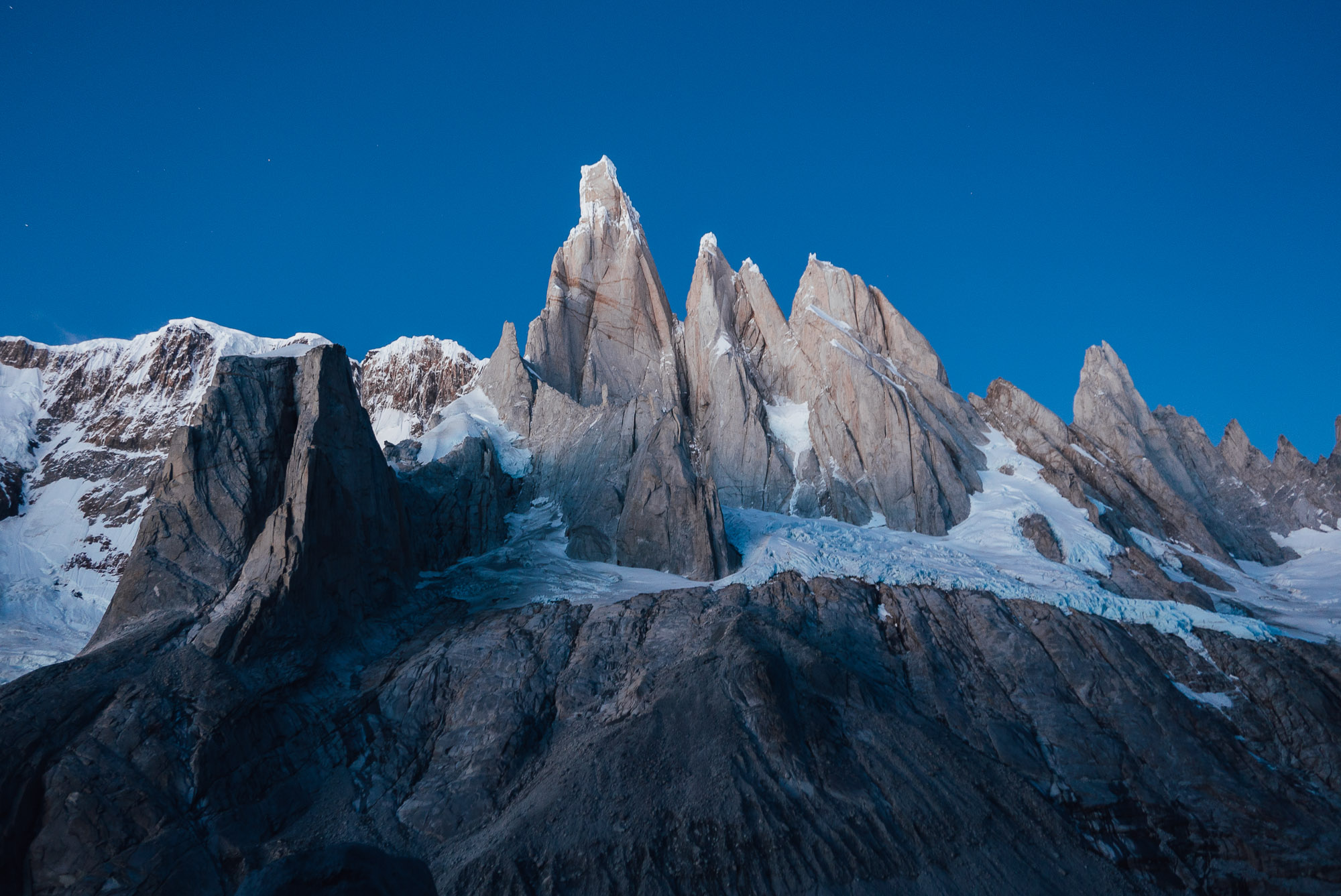
The Torres at dawn from the Torre Valley.
After hiking out of the Torre Valley in a storm, I only had a few days left before my flight back home. The forecast showed one last day of good weather the day before I had to catch a 6am bus to the airport. If we went for something big, I would likely have to hike solo across a broken glacier and navigate a descent I’d never done before in the dark. It would be a bit risky and a bit of a gamble with the possibility of missing a very expensive flight. But there was one route, the Pilar Rojo on Mermoz, that I really wanted to climb, so Austin and I decided to go for it. At high camp, a couple good friends from Seattle, Andy and Kelsey, offered to help me get out of the mountains safely and in time for my bus. They had a car and would wait for me to get back to the road via a trail I knew well, and drive me back to town, so I wouldn’t have to navigate an unfamiliar technical descent on my own. I didn’t have access to a car and it would’ve been too late to get a taxi, so I hadn’t considered this option, but it was a huge relief when they made it possible.
The next day Austin and I successfully climbed the Pilar Rojo with four of our other friends right behind us. We almost onsighted the consistently 5.11+, 2000foot climb, except for a short slab traverse that Austin aided through and I sent third try. It was a battle to keep it together for the last bit of burly crack climbing—Austin was cramping up and I just felt super tired. The climbing was the definition of “splitter,” almost too splitter for me, a pretty mediocre crack climber. We got off the mountain in the light and I ended up making it back to town by 3am. After a two-hour nap, I caught my bus to the airport, and was quickly transported back to Seattle. I felt extremely lucky to end my trip with such a high quality Patagonia free climb. It’s possible that that last day was the only day that conditions aligned enough to make climbing the Pilar Rojo possible. A couple of our friends had attempted that route several times that season and never got a chance to take it to the top.

Austin on the first 11d pitch. Splitter!
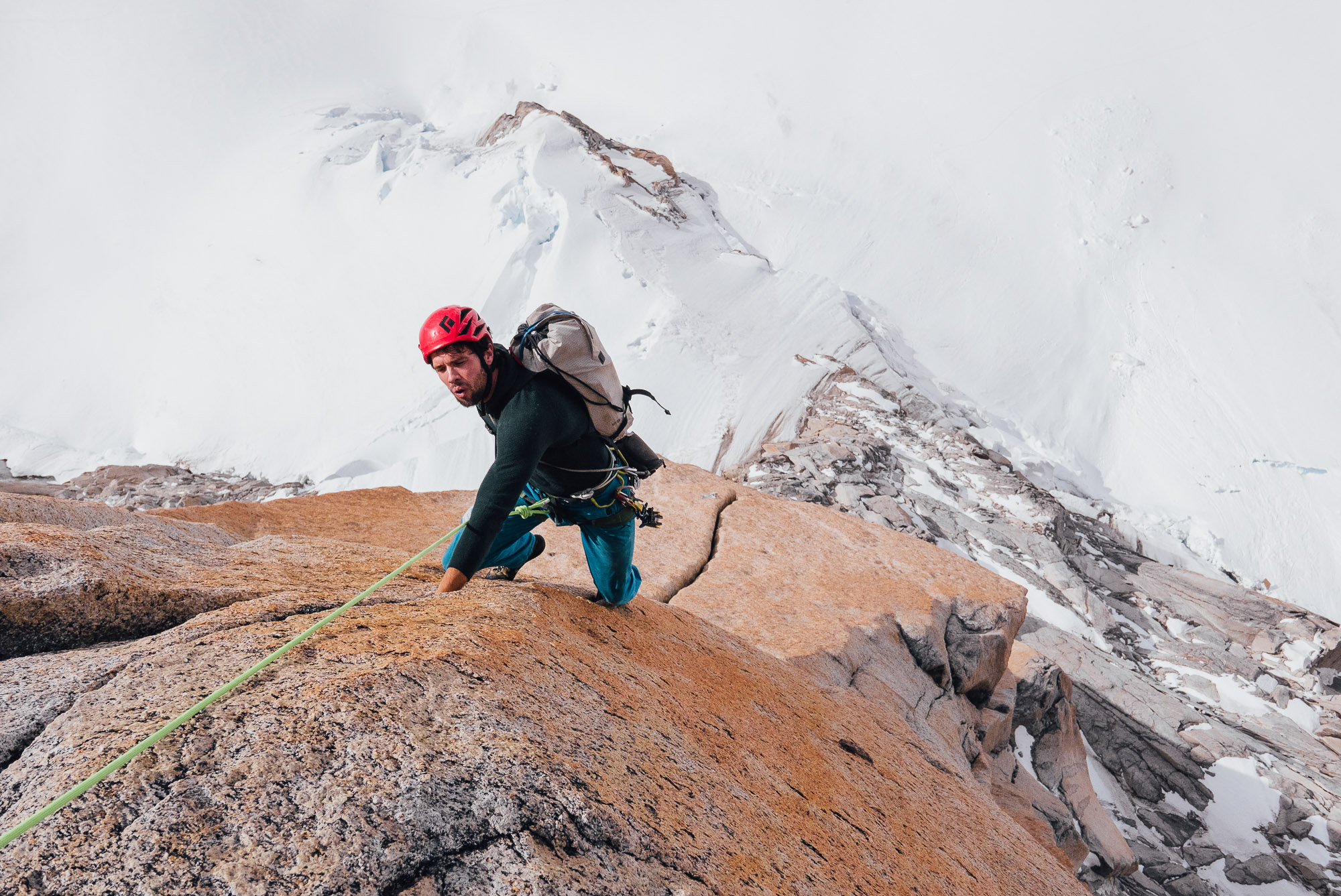
Austin on one of the only 5.10 pitches. Splitter hands for 200 feet!
Naturally, I wonder if I’ll go back to such an amazing place. When I was down there I was already talking about being back next year. Back home, I wonder if I’d like to use my “big trip budget” to see another part of the world. I’m sure I will eventually go back, but I’m not sure when. I honestly was surprised at how high-quality the alpine granite was—it really is good. But what wasn’t surprising was how hard it is to get good conditions to rock climb—Patagonia’s stormy reputation is extremely accurate. That’s partly what makes it special though, and also what would make a rock climber like me secondguess going back! Doing a rad alpine rock climb down there is not guaranteed, but I was lucky to do a few.
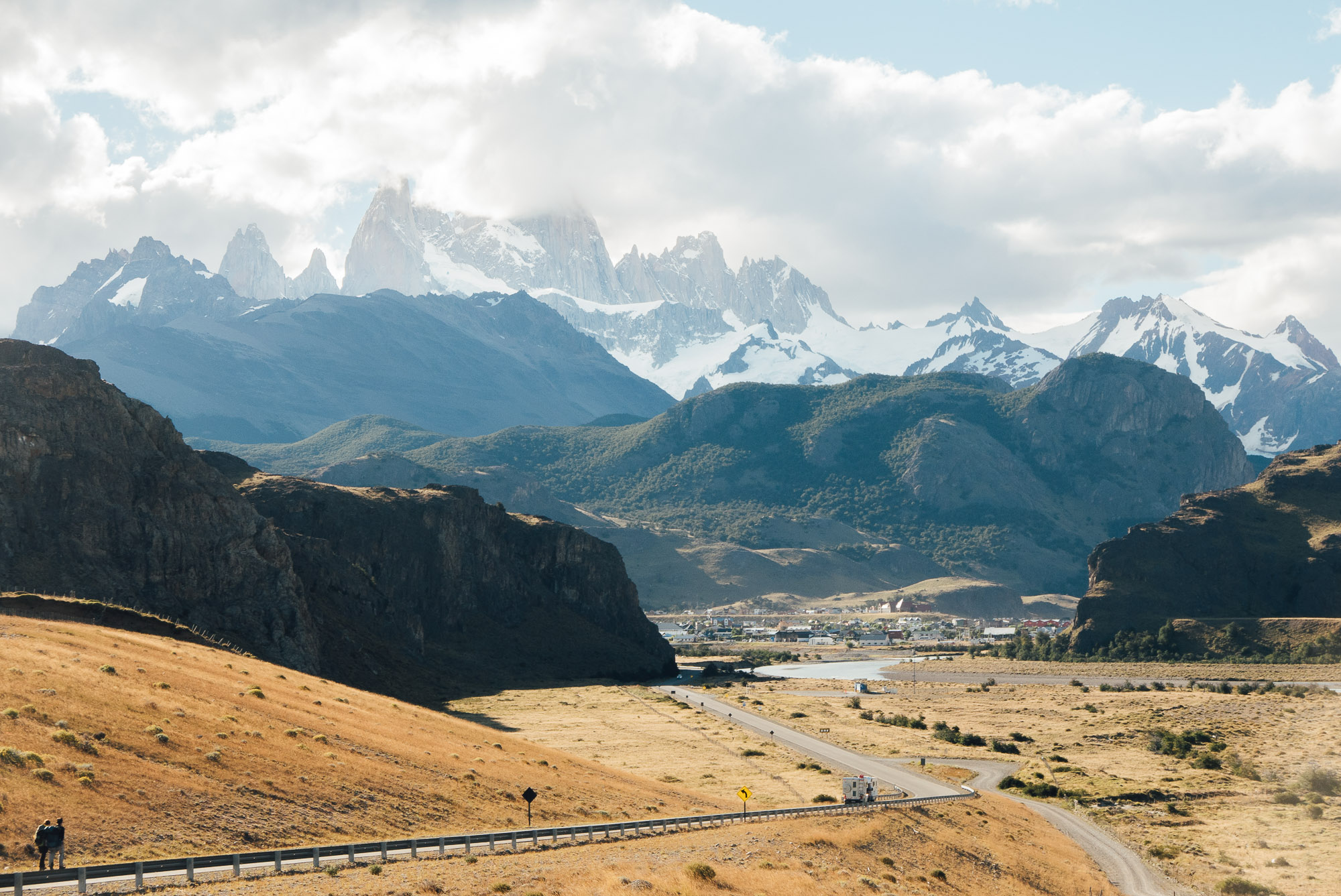
Chaltén below a shrouded Fitz Roy.
Archive
2023
Dreefee and Crystal Dawn
Rubbernecker
2022
Long's Peak Diamond
Seattle Design Festival Interview
Seeing Circuits: an Interview with the Bouldering Project
2020
Vanishing Point 2.0: A Classic Route Modernized
Interview with Steven Dimmitt
Training Using Circuits
Cuba
2019
Dark Side of Liberty
The Bugaboos
Blue Jeans Direct: The End of the Canadian Rockies Ticklist
The Path
The Shining Uncut
Castles in the Sky
Scarface
Index's First 5.14
Turkey
2018
Patagonia
2017
Dark Side of the Valley
Vanishing Point
Winter Climbing
First Route in the Alaska Range
New York Gully